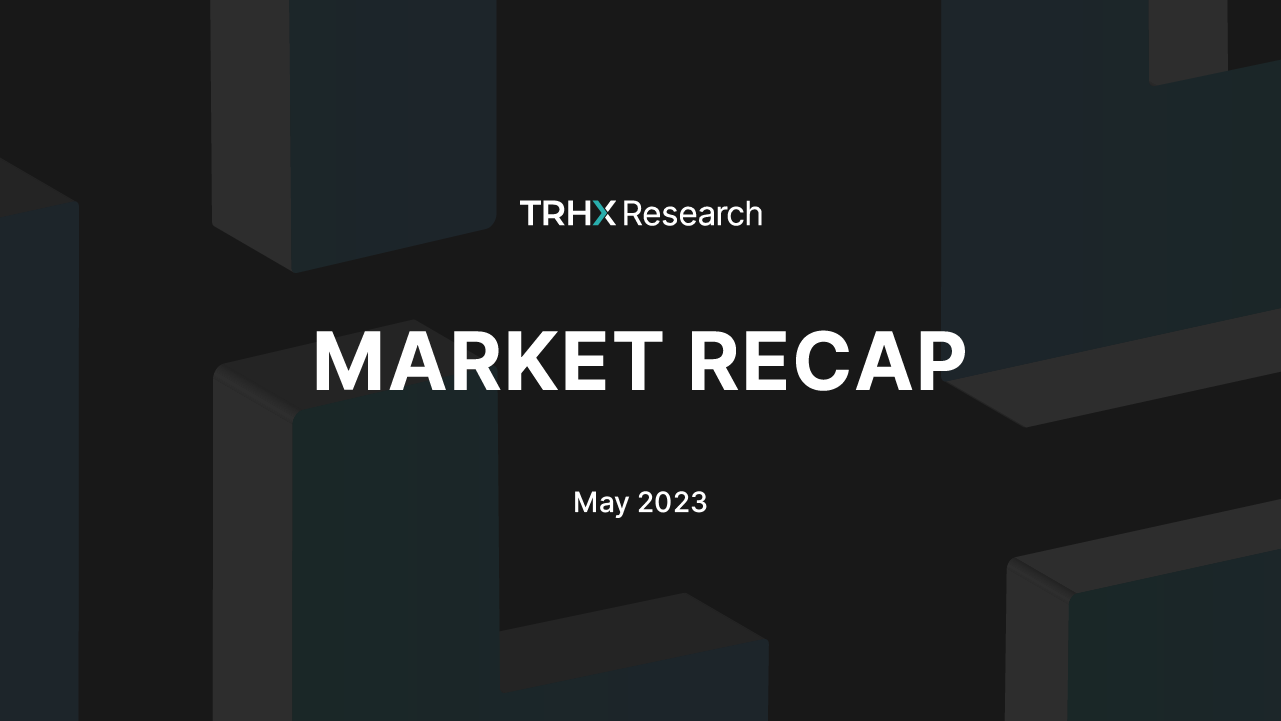Welcome to the monthly crypto market recap for May 2023! The crypto market encountered a series of challenges and noteworthy developments during this month. Continual uncertainties surrounding rate hikes and inflation cast a shadow of a doubt, dampening market sentiment and impacting investment decisions. Moreover, macroeconomic difficulties arose with the looming possibility of a US default on its debt without raising the debt ceilings, further exacerbating concerns.
In the midst of these struggles, the market experienced a surge of memecoins, notably PEPE, which reached a market cap of $1 billion during its all-time high in the middle of the month. Another noteworthy development was the emergence of BRC-20 tokens through Ordinal Inscriptions, bringing new possibilities and innovation to the crypto space.
However, it is important to note that the overall market conditions remained unfavorable, with only a handful of tokens generating noticeable positive returns throughout the month. Join us as we delve into the key highlights and narratives that shaped the crypto market in May, despite its challenging landscape. Stay informed with our comprehensive monthly market recaps at TRHX Research and our daily market analysis with TRHX Pulse, providing valuable insights and analysis to navigate the dynamic world of cryptocurrencies!
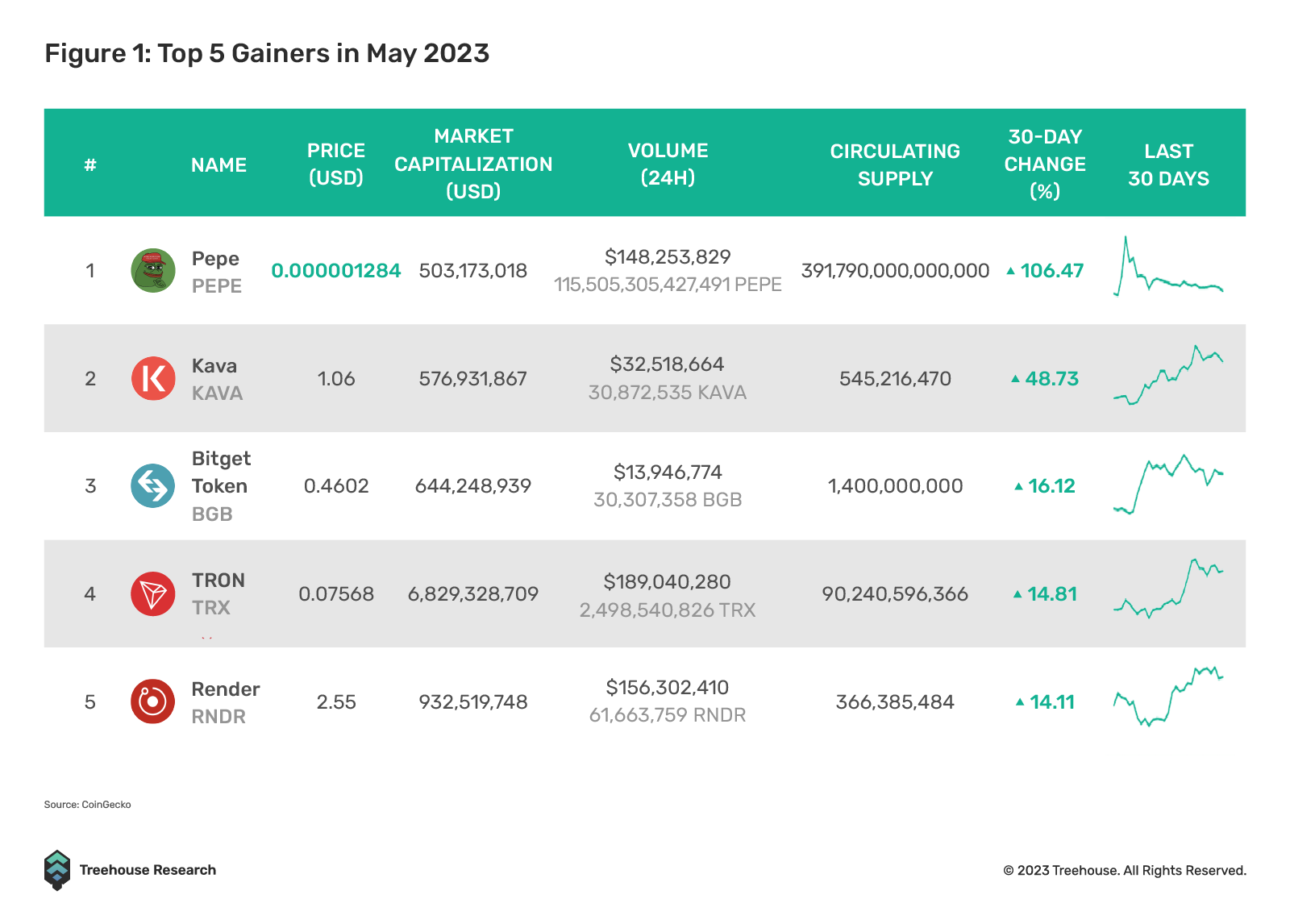
Pepe (PEPE)
PEPE, the memecoin inspired by Pepe the Frog, has taken the crypto market by storm, appreciating a staggering 373.5% since the start of May. The significant price increase is largely attributed to the growing interest in memecoins, a rewarding staking system, and a unique burning mechanism.
Launched on Ethereum, PEPE led the memecoin craze that has swept the crypto world. As a homage to the Pepe the Frog internet meme, this token carries a humorous charm that resonates with a certain slice of the crypto market. Beyond the lighthearted exterior, PEPE incorporates useful functionalities: a no-tax policy, a rewarding system for long-term stakers, and a burning mechanism to keep PEPE coins deflationary.
On 8 May 2023, PEPE’s market cap swelled to a high of $1.1 billion, creating an abundance of wealth for early adopters. Its roadmap shows a clear path towards greater exposure, including listings on CoinMarketCap, trending on Twitter, and securing positions on tier-1 exchanges. While the dream of a “meme takeover” is yet to be realized, the considerable gains in the memecoin market suggested enormous interest from the public.
Despite the team behind PEPE remaining anonymous, they have successfully cultivated an engaged community via social media. The distinct features of PEPE like its rewarding system for long-term stakers, scarcity-oriented burning mechanism, and no-tax policy make it a unique player among the flood of meme coins. PEPE’s maximum supply is set at a staggering 420.69T, but with a good portion already burned and the rest under a fair redistribution system, it is clear that the tokenomics are designed to reward those who hold.
Kava (KAVA)
Kava experienced a remarkable surge in May, with an impressive increase of 46.2%, reaching its highest level of the year at $1.28.
Kava is a DeFi lending protocol built on Tendermint Core, using the speed and interoperability of Cosmos. By collateralizing cryptocurrencies to mint USDX, Kava’s native stablecoin, which is used to price all loan instruments, users receive weekly rewards in the form of KAVA, the governance token. Token holders can then participate in governance to vote on software policies and rules, including collateral options, collateralization ratio, and borrower fees.
On 18 May, the Kava 13 update went live, marking a significant milestone for the network. This update introduces a range of enhancements aimed at assisting developers in scaling and accelerating their protocols while improving the overall user experience. The network update included various modifications, such as optimizing full node programming and expanding the hosting provider.
Additionally, the latest update introduces a new internal bridge between Cosmos and Ethereum. The bridge will unlock liquidity and amplify the usability of protocols deployed on Cosmos SDK and EVM chains. Leveraging the security of IBC consensus, users can seamlessly transfer native Cosmos assets to a wide array of protocols deployed on Kava EVM. This streamlined bridging experience minimizes the need for multiple clicks, reduces waiting times, and eliminates uncertainties associated with relying on third-party middle-chain bridges.

Total value locked (TVL) on the Kava chain has been consistently growing since the start of the year. Over the past month, the three leading protocols on the Kava chain, namely Kava Earn, Kava Lend, and Kava Liquid, have witnessed significant rises in their TVL, ranging from 15% to an impressive 40%.
Meanwhile, on 23 May, DAXA, a digital currency alliance comprising South Korea’s top five cryptocurrency exchanges (UpBit, Bithumb, Coinone, Korbit, and Gopax), lifted the investment warnings and resumed deposits for Kava. This announcement resulted in a significant surge in the value of the Kava token, with its price pumping as much as 16.3%.
Earlier, DAXA issued warnings regarding Kava due to concerns about stablecoins associated with KAVA not being consistently valued at one dollar. However, after a thorough evaluation, DAXA no longer perceives Kava as a source for significant risks, and the reasons behind the cautionary designation have been addressed.
Finally, Kava Proposal #141 has been successfully approved, which entails the complete cessation of all Kava emissions, including Proof-of-Stake (POS) rewards, Kava Rise rewards, and other types of reward emissions, effective indefinitely from 31 December 2023, putting a stop to future supply inflations.
Bitget Token (BGB)
BGB has outperformed both BTC and ETH with over 150% growth year-to-date (YTD) and has recorded another 14.1% increase in May. This surge can be attributed to a few key developments in the Bitget ecosystem, namely: the introduction of the Super Airdrop promotion, listing of BRC-20 tokens, and strong performance metrics in the Transparency Report.
Bitget, established in 2018, is a large cryptocurrency exchange with futures trading and copy trading services as its key features. Currently, the platform serves over 8 million users in more than 100 countries and regions. According to CoinCodex, Bitget is currently a top-5 futures trading platform and a top-10 spot trading platform. BGB holders also enjoy certain privileges, including early access to new projects and discounts on the Bitget platform.
With the introduction of the Super Airdrop feature on 8 May, eligible BGB holders could receive airdrops of any new asset listed on Bitget. To qualify, holders needed an average balance of at least 4,000 BGB tokens for 15 consecutive days, which equated to an estimated $2,000 investment at that time. Soon after, Bitget announced that they would list ORDI and had the first-mover advantage of being one of the few exchanges to offer trading on BRC-20 tokens. Following these announcements, the token rallied 30% over the next three days.
In addition, Bitget’s Transparency Report outlines their impressive first quarter achievements with 27% quarter-on-quarter (QoQ) growth in futures trading volume, 146% increase in BGB holders, and 35% QoQ growth in website and mobile traffic. In the near future, BGB holders can also expect a zero fee withdrawal, a new VIP system, and a higher annual percentage yield (APY) under their BGB Earn program.
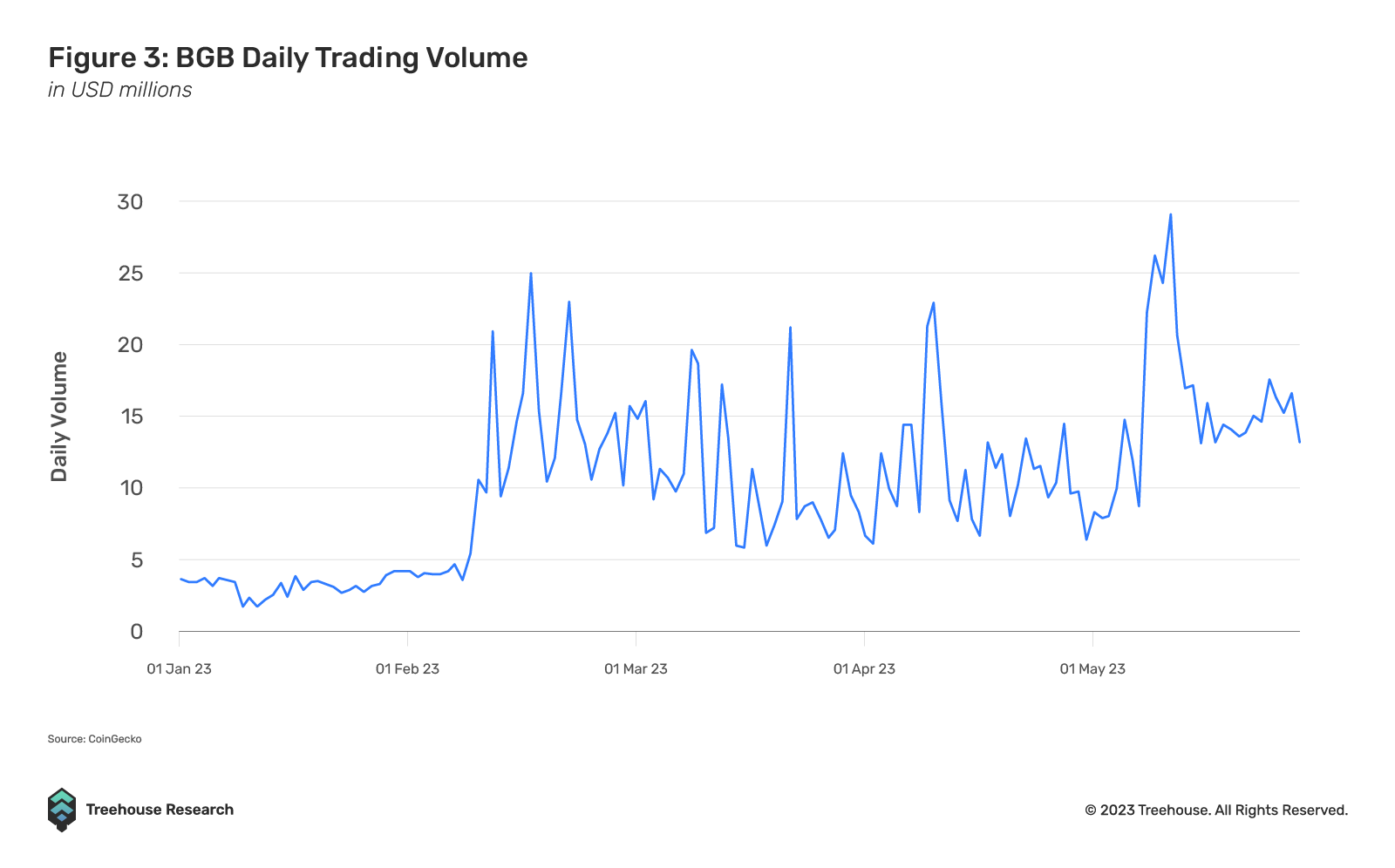
Tron (TRX)
While the majority of cryptos have generated negative returns during the past month, TRX has ended the month with a 16.2% gain, of which more than 13% were generated in the span of three days between 20 to 23 May.
Tron (TRX) is a token created by crypto entrepreneur Justin Sun as the native token for the Layer-1 (L1) Tron Network that aims to further decentralize the internet. Tron provides smart contract capabilities through its blockchain and has a virtual machine called Tron Virtual Machine (TVM), enabling smart contracts to utilize the TRC-20 technical standards while remaining ERC-20 compliant.
The rapid gains observed in TRX over the past month caught many crypto market participants by surprise, as there were no positive news or fundamental changes associated with the project. Furthermore, Tron founder Justin Sun continues to face unresolved legal issues with the SEC. Consequently, although there is no concrete evidence, there is a belief among many that these gains could be the result of insider manipulations.
Analyzing the blockchain’s fundamental metrics reveals no significant changes in its TVL YTD. JustLend and JustStables maintain a dominant TVL position on the network, accounting for nearly 90% of the total network TVL, with few other active projects on the Tron Network.
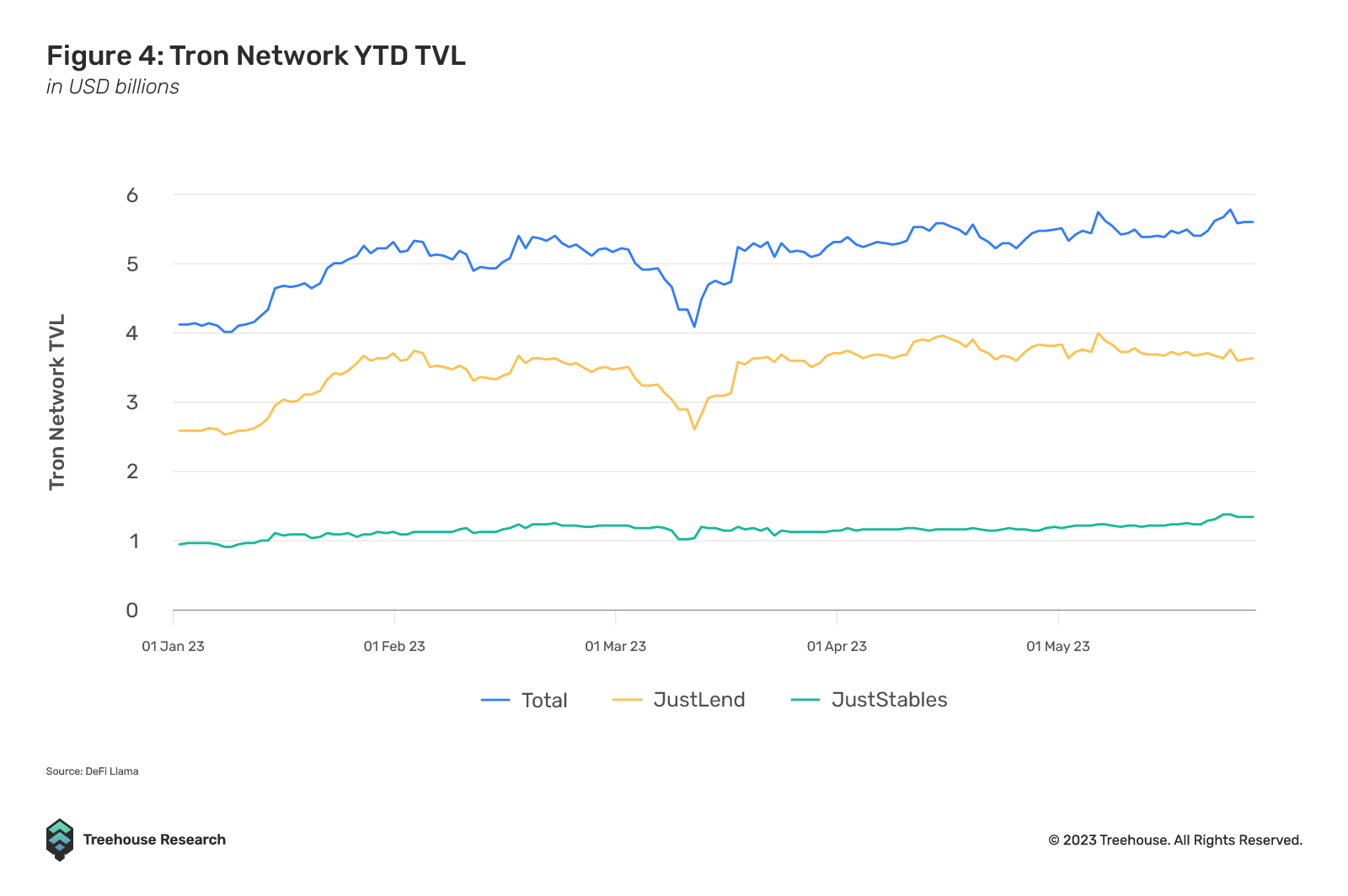
On the other hand, the Tron DAO tweeted on 20 May, citing a report from Token Terminal, which shows stagnant growth in revenue and daily active users.
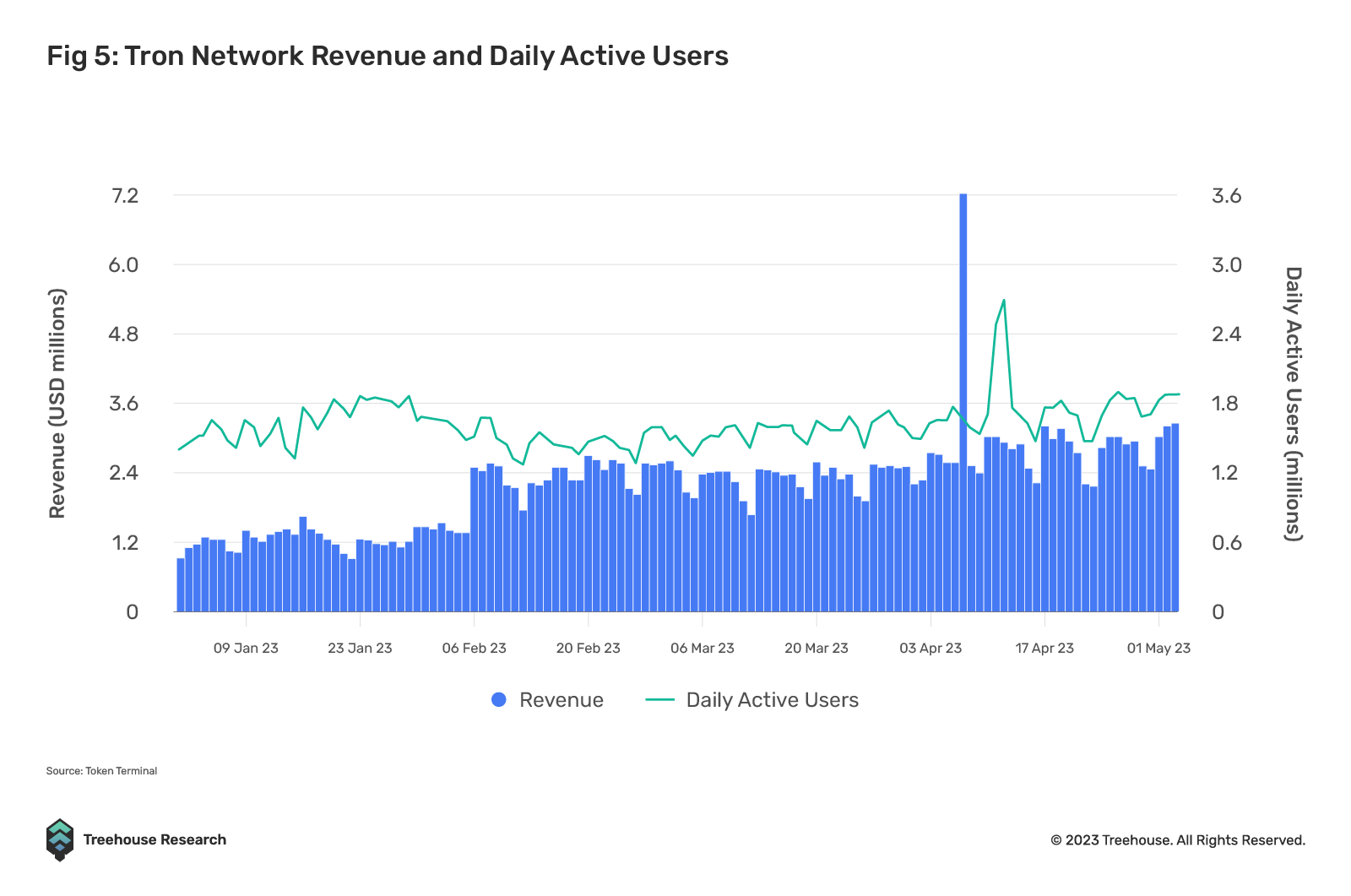
Given the absence of any other major news or developments that could explain the positive returns, it is challenging to determine the cause of this sudden surge amidst bear market conditions. However, the on-chain crypto tracking platform MistTrack has detected significant movements from centralized exchanges on the Tron Network. During the surge, addresses associated with OKX were found to have transferred 194 million TRC-20 USDT to Kraken. Further investigation reveals that transfers between these two exchanges amounted to approximately 264 million USDT within the month, with the recent transfer representing 73.5% of the monthly volume. Although there is no solid evidence, these transfers raise questions regarding potential market manipulation or a front-run on an upcoming TRX move.
Render (RNDR)
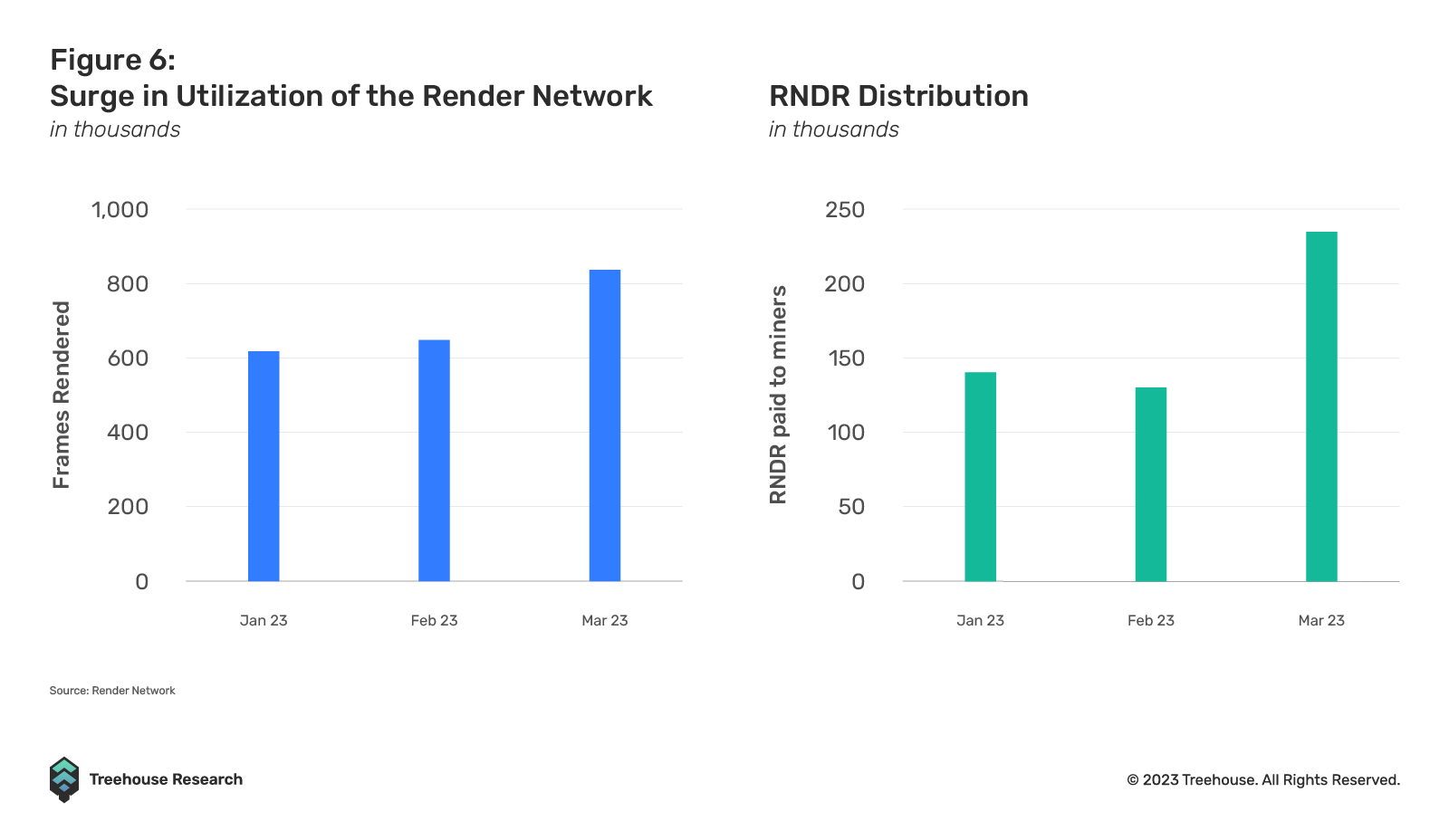
The Render Network (RNDR) has outperformed the overall crypto market for the second consecutive month, with an impressive 13.1% gain. This surge can be attributed to the rise in Artificial Intelligence (AI) technologies in the US markets, which has created a positive spillover effect on crypto projects that support AI growth.
The Render Network is a decentralized GPU processing platform that provides near real-time rendering for users’ GPU compute needs, such as AI. Catering to both current 3D rendering tasks and emerging 3D applications, it utilizes idle GPU compute capability to improve render speed, reduce costs, and increase scalability. The network also provides open access to a growing suite of render and related software providers, making it appealing to the creative industry.
The positive catalyst for RNDR’s performance this month can be linked to notable tailwinds from the traditional market, such as Nvidia’s GPU demand forecast and cloud providers’ focus on AI firepower. Google’s enthusiasm for AI was also evident at its I/O developer conference, and RNDR’s outperformance coincided with the release of Google’s keynote. The AI boom, driven by ChatGPT, has increased demand for high-computing GPUs, and investors recognize RNDR’s potential as an “infrastructure play” due to its decentralized GPU processing capabilities.
In addition to benefiting from AI and GPU demand tailwinds, Render Network has announced exciting developments this month. The new Render Network Foundation website serves as a community hub, showcasing creators’ artwork and facilitating user discovery. Render Network’s Q4 2022 – Q1 2023 metrics show steady usage and progress in expanding product reach. With significant development work on complex geometry exporting and the addition of Stable Diffusion services, Render Network’s infrastructure is well-positioned for growth throughout the year.
Verdict
The crypto market performance in May 2023 has been disappointing, characterized by a contraction of the total crypto market cap and a shift in investor attention towards memecoins. Looking ahead to June 2023, it is important to consider several significant events and market catalysts. The ongoing economic uncertainty stemming from debt debates may pose challenges and contribute to a more risk-averse investor sentiment, potentially affecting the overall growth of the crypto market. Additionally, the crypto market continues to be influenced by global economic events and policy changes, including factors such as interest rate decisions and inflation data.
Lastly, the implementation of new crypto regulations in Hong Kong on 1 June 2023 and China’s recently released Web3 White Paper may suggest a potential shift in China’s stance on cryptocurrencies, recognizing them as an “inevitable trend for future Internet industry development”. Consequently, it is important to behold the developments and the policy supports towards Chinese-founded cryptocurrency projects throughout the month of June.
Disclaimer
This publication is provided for informational and entertainment purposes only. Nothing contained in this publication constitutes financial advice, trading advice, or any other advice, nor does it constitute an offer to buy or sell securities or any other assets or participate in any particular trading strategy. This publication does not take into account your personal investment objectives, financial situation, or needs. Treehouse does not warrant that the information provided in this publication is up-to-date or accurate.

Hyperion by Treehouse reimagines workflows for digital asset traders and investors looking for actionable market and portfolio data. Contact us if you are interested! Otherwise, check out Treehouse Academy, Insights, and Treehouse Daily for in-depth research.
